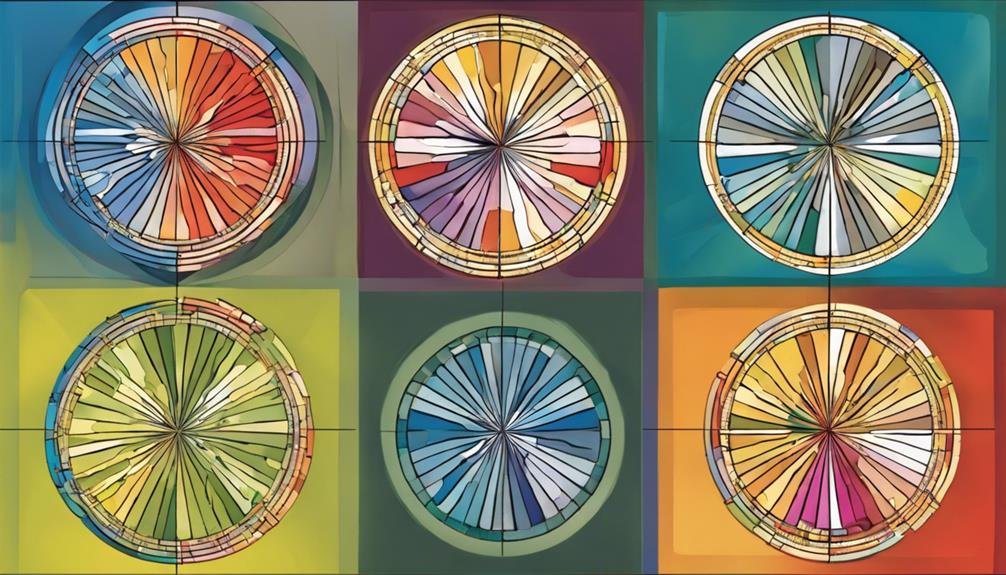As we dive into the depths of the Ultimate DISC Assessment Scoring Guide, we are faced with the challenge of comprehending human behavior within the workplace. The complex interactions between individuals’ characteristics that contribute to effective teamwork and productive partnerships should not be overlooked.
By unraveling the nuances of each DISC trait and deciphering the assessment results, a world of possibilities opens up in terms of optimizing team performance and communication strategies. Let's navigate this roadmap together and uncover the transformative power that lies within this comprehensive guide.
Key Takeaways
- Understand trait combinations to optimize team dynamics.
- Analyze visual representations for personality insights.
- Apply DISC results for tailored communication and leadership.
- Improve relationships by adapting to DiSC styles for effective interactions.
Understanding the Four DISC Traits
Understanding the Four DISC Traits provides valuable insights into individuals' behavioral tendencies and preferences, crucial for identifying strengths, weaknesses, and communication styles.
The DISC assessment evaluates Dominance, Influence, Steadiness, and Conscientiousness traits in individuals, each shedding light on specific behavioral characteristics. Dominance reflects assertiveness and goal orientation, highlighting individuals who are results-driven and decisive.
Influence emphasizes sociability and enthusiasm, identifying those who excel in social settings and are persuasive communicators. Steadiness showcases traits of empathy and dependability, indicating individuals who prioritize harmony and teamwork.
Conscientiousness focuses on precision and reliability, pointing towards detail-oriented and organized individuals. Recognizing these traits helps in comprehending how individuals approach tasks, interact with others, and navigate challenges.
Understanding the nuances of these traits enables us to tailor our communication styles effectively, leverage strengths, address weaknesses, and foster productive collaborations within diverse teams.
Interpreting DISC Assessment Results

Transitioning from understanding the Four DISC Traits, interpreting DISC Assessment results involves analyzing scores ranging from 0 to 100 for each personality trait to gain insights into individuals' behavioral tendencies and preferences.
- Scores Range: DISC assessment results assign scores between 0 and 100 for distinct personality traits.
- Trait Mix: Individuals usually display a combination of traits rather than extreme scores on the assessment.
- Abbreviations: Reports typically summarize personality types using abbreviations like D or SC based on the scores obtained.
- Effective Interpretation: Understanding the combinations of traits is vital for effectively interpreting assessment results to aid in leveraging strengths and addressing weaknesses.
Analyzing DISC Assessment Charts
In analyzing DISC Assessment charts, we observe visual representations such as the four-quadrant circle chart and the 12-slice circle chart to interpret trait scores and combinations. These charts provide a snapshot of an individual's personality by plotting their scores across the four traits. A dot on the chart indicates the average score, offering a quick reference point for trait distribution.
Profile graphs further enhance the analysis by displaying trait scores in line charts, allowing for a detailed examination of adapting, natural, and overall profiles. By delving into these charts, we can gain insights into individual traits, strengths, and tendencies. Moreover, interpreting the charts enables us to leverage these strengths effectively, address potential weaknesses, and optimize team dynamics based on the trait distributions.
Understanding these visual representations is crucial for utilizing the full potential of DISC assessment results in various professional settings.
Applying DISC Results at Work

By applying DISC results at work, organizations can tailor communication and leadership styles to individual traits, enhancing overall workplace effectiveness. Leveraging these insights can lead to improved employee performance and collaboration.
Here are four key ways to apply DISC results in the workplace:
- Tailoring Communication: Utilize DISC assessments to understand how different personality styles prefer to communicate. Adjusting communication methods based on these preferences can lead to clearer and more effective interactions.
- Adapting Leadership Styles: Identify leadership approaches that align with the dominant traits of team members. This tailored leadership can motivate individuals and maximize their potential within the organization.
- Providing Targeted Training: Use DISC results to offer personalized training and development opportunities. This targeted approach can address specific needs based on individual personality traits, enhancing overall skill development.
- Enhancing Team Dynamics: Foster collaboration by creating teams with diverse DISC profiles. Understanding these profiles can help in building well-rounded teams that leverage each member's strengths and improve overall productivity.
Enhancing Relationships Through DISC
Understanding DISC profiles enhances relationships by pinpointing communication styles and preferences, facilitating improved teamwork and collaboration. When interpreting your DISC assessment report, identifying DiSC styles can greatly impact how you interact with others.
By recognizing behavioral styles, individuals can tailor their communication to match the preferences of those around them, leading to more effective interactions and better understanding. This personalized approach can significantly improve communication within relationships, whether personal or professional, ultimately building trust and rapport.
Moreover, understanding DISC profiles can play a crucial role in conflict resolution by providing insights into the root causes of misunderstandings and enabling individuals to address conflicts in a more constructive manner. By applying DISC insights in relationships, individuals can foster empathy, enhance understanding, and develop strategies for more successful communication, ultimately strengthening the bonds between people.
Frequently Asked Questions
What Is a Good Score on the DISC Test?
A good score on the DISC test typically falls around 50, showing a balanced mix of personality traits. Scores above 50 indicate stronger inclinations towards specific traits, while lower scores suggest different behavioral styles.
What Is the Rarest Disc Profile?
We discovered that the rarest DiSC profile is SC, a unique blend of Steadiness and Conscientiousness. SC individuals exhibit reliability, empathy, and analytical skills. They focus on quality and cooperation, making them valuable team players.
What Is the Most Common DISC Personality Type?
We find the most common DISC personality type to be the S style, representing 32-37% of the population. Individuals with this type value stability, harmony, and dependability, emphasizing relationships and peace.
How Do You Calculate DISC Test?
To calculate a DISC test, average the scores across traits. Individual trait scores reveal dominant types, summarized with abbreviations like D or SC. Comprehending score combinations aids in interpreting results to understand personality types.
How Can I Use the Ultimate DISC Assessment Scoring Guide to Interpret My Personality Results from the DISC Assessment Wheel?
The ultimate DISC assessment scoring guide offers a comprehensive way to interpret your personality insights from the DISC assessment wheel. By understanding your results within the context of the disc assessment wheel personality insights, you can gain valuable self-awareness and utilize this knowledge to navigate various social and professional interactions.
Conclusion
In conclusion, understanding and applying the insights from the Ultimate DISC Assessment Scoring Guide can greatly benefit team dynamics and performance in the workplace.
By recognizing and leveraging individual traits, teams can communicate effectively, collaborate efficiently, and ultimately achieve success.
As the saying goes, 'teamwork makes the dream work,' and by utilizing the DISC assessment, organizations can create a harmonious and productive work environment.









